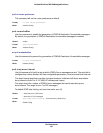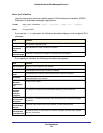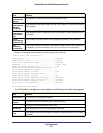
IPv6 Commands
371
ProSafe M4100 and M7100 Managed Switches
Note: If you use the connected keyword for <protocol>, the all option is not
available because there are no best or non-best connected routes.
The show ipv6 route command displays the routing tables in the following format:
Codes: C - connected, S - static
O - OSPF Intra, OI - OSPF Inter, OE1 - OSPF Ext 1, OE2 - OSPF Ext 2
ON1 - OSPF NSSA Ext Type 1, ON2 - OSPF NSSA Ext Type 2
The columns for the routing table display the following information:
Code
IPv6-Prefix/IPv6-
Prefix-Length
Preference/Metric
Tag
Next-Hop
Route-Timestamp
• Days:Hours:Minutes if days > = 1
• Hours:Minutes:Seconds if days < 1
Interface
To administratively control the traffic destined to a particular network and prevent it from
being forwarded through the router, you can configure a static reject route on the router. Such
traffic would be discarded and the ICMP destination unreachable message is sent back to the
source. This is typically used for preventing routing loops. The reject route added in the RTO
is of the type OSPF Inter-Area. Reject routes (routes of REJECT type installed by any
protocol) are not redistributed by OSPF/RIP. Reject routes are supported in both OSPFv2
and OSPFv3.
Format show ipv6 route [{<ipv6-address> [<protocol>] |
{{<ipv6-prefix/ipv6-prefix-length> | <slot/port>} [<protocol>] |
<protocol> | summary} [all] | all}]
Modes
• Privileged EXEC
• User EXEC
Term Definition
Route Codes
The key for the routing protocol codes that might appear in the routing table output.
Term Definition
The code for the routing protocol that created this routing entry.
The IPv6-Prefix and prefix-length of the destination IPv6 network corresponding to this
route.
The administrative distance (preference) and cost (metric) associated with this route. An
example of this output is [1/0], where 1 is the preference and 0 is the metric.
The decimal value of the tag associated with a redistributed route, if it is not 0.
The outgoing router IPv6 address to use when forwarding traffic to the next router (if any)
in the path toward the destination.
The last updated time for dynamic routes. The format of Route-Timestamp will be
The outgoing router interface to use when forwarding traffic to the next destination. For
reject routes, the next hop interface would be Null0 interface.


















